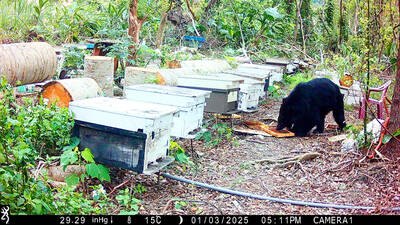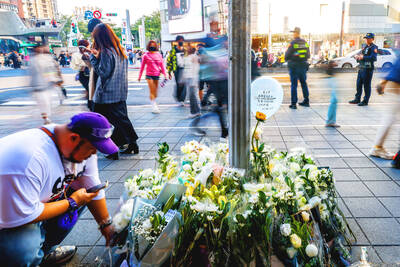Civic, environmental and Aboriginal groups slammed the Cabinet yesterday over its proposed typhoon reconstruction bill, saying the proposal lacks a mechanism to involve victims in the rebuilding of their hometowns.
To speed up the reconstruction of areas devastated by Typhoon Morakot, the Cabinet’s bill aims to coordinate efforts among central and local government authorities, allowing reconstruction to be exempt from several laws the Cabinet believes would slow down the process. The bill would also provide a legal basis for banning human habitation in risky areas and for forced eviction of communities from those areas.
The Cabinet plans to spend as much as NT$100 billion (US$30 billion) on reconstruction.
Many non-governmental groups have attacked the Cabinet’s plan.
“The reconstruction bill is nothing more than a bill to expand government power and to waste taxpayers’ money,” Green Party Taiwan Secretary-General Pan Han-shen (潘翰聲) told a forum yesterday.
The bill “gives overwhelming power to an incapable government,” he said.
Pan said that waiving laws such as the Urban Planning Act (都市計劃法), Water Conservancy Act (水利法) and Environmental Impact Assessment Act (環境影響評估法) could turn the reconstruction effort into an environmental disaster that might trigger more severe devastation in future.
“We needed to rescue victims as quickly as possible, but our incapable government failed to do so. And while we need to carefully plan reconstruction to prevent future disasters, the government is trying to do it too hastily,” Pan said.
‘HORRIBLE BILL’
Tseng Hsu-cheng (曾旭正), chairman of Community Empowering Society Taiwan, said compared with the Provisional Act Governing Reconstruction After the 921 Earthquake (九二一震災重建暫行條例) adopted 10 years ago, “the draft typhoon reconstruction bill is horrible.”
“I think the reconstruction bill would have been much better if the Cabinet just spent one night copying the 921 reconstruction bill,” Tseng said.
He said there has been no attempt to involve local communities in the reconstruction or rebuild local industries.
Yabi Dali, a social worker who has worked in isolated communities in the Alishan (阿里山) area, agreed.
“Government officials are talking about resettling entire villages while the villagers who are still cut off from the outside don’t know about the plan,” she said.
“The reconstruction effort should not only coordinate different local and central government agencies, but should also involve representatives of the communities to be reconstructed,” she said.
Lahuy Icyeh, secretary of the Smangus Aboriginal Community Development Association, said community members should be allowed to rebuild their own houses.
Since about 80 percent of the disaster areas are in Aboriginal regions, Lahuy called on the government to respect Aborigines’ wishes to rebuild their communities near where they used to live if it’s not possible to rebuild the communities on the former sites.
“Don’t think that it’s good for the survivors if you move them somewhere close to a 7-Eleven or McDonald’s,” he said.
Liglove Awu, a member of the Alliance for Reconstruction of Aboriginal Communities in Southern Taiwan, said that since the Council of Indigenous Peoples has conducted a survey of traditional Aboriginal domains, “you can always resettle Aboriginal communities somewhere safe within their traditional domains instead of moving everybody to the plains.”
PRESERVE CULTURE
Huang Chih-hui (黃智慧), a board member of the Millet Foundation — which promotes and preserves indigenous cultures — urged the government to also pay attention to reconstruction and preservation of culture.
“The disaster has not only destroyed buildings and landscape in Aborigine communities, but also threatened their culture,” Huang said. “Places for holding important ceremonies, historic events, or myths may just disappear after communities are resettled.”
The activists will deliver copies of their suggestion to all 112 legislators and party caucus offices at 9am today.
Executive Yuan Spokesman Su Jun-pin (蘇俊賓) said the government has no plan to change the makeup of the post-Typhoon Morakot Reconstruction Committee but promised that the opinions of local governments and victims were important to the commission.
The 31-member committee, which will be chaired by Premier Liu Chao-shiuan (劉兆玄), will have 30 officials from different government agencies, plus the heads of Delta Electronics, Uni-President Enterprises Corp, Taiwan High Speed Rail, China Steel and one university president and four professors.
Su said the committee would keep in close contact with each local reconstruction committee in typhoon-affected county or city governments so that victims can have their say on the relocation of their villages and other reconstruction projects.
The Executive Yuan will listen to what local governments and victims have to say and take their opinions seriously before any decision is made at the committee level, Su said.
The opinion of victims’ opinions is the main principle guiding of the committee and was more important than having two or three victims on the committee as a symbolic gesture, Su said.
Meanwhile, Legislative Speaker Wang Jin-pyng (王金平) criticized the Democratic Progressive Party (DPP) caucus’ suggestion that the central government seek unlimited funding for post-Morakot reconstruction.
“It is impossible to grant the central government an unlimited budget, but we can maintain certain degree of flexibility,” Wang said.
“For example, [the Executive Yuan planned to seek] NT$100 billion [US$3 billion], but the DPP wants a minimum of NT$200 billion. Legislators can negotiate and finalize an amount that could help reorganize and restore our land and complete the disaster relief and reconstruction,” he said.
NEGOTIATIONS
Wang said he would convene a negotiation session this morning before the legislature’s extraordinary session to review the Cabinet’s special budget request begins in the afternoon.
Lawmakers are scheduled to complete the review by Thursday, which would support the government’s plan to take out loans for reconstruction effort.
DPP caucus whip Wang Sing-nan (王幸男) said putting a cap on reconstruction spending would be irresponsible.
“The cost of the reconstruction plans proposed by Chiayi, Tainan, Kaohsiung and Pingtung county governments exceeds NT$90 billion. This figure does not include the reconstruction plan for Taitung or the repairs of roads and bridges under the jurisdiction of the central government,” Wang Sing-nan said.
The DPP lawmaker said the Executive Yuan’s proposed budget would not be enough to cover the reconstruction work, since it took about NT$210 billion to rebuild homes and infrastructures after the 921 Earthquake.
Chinese Nationalist Party (KMT) caucus whip Lin Yi-shih (林益世), however, said the amount of budget was negotiable.

SHIPS, TRAINS AND AUTOMOBILES: The ministry has announced changes to varied transportation industries taking effect soon, with a number of effects for passengers Beginning next month, the post office is canceling signature upon delivery and written inquiry services for international registered small packets in accordance with the new policy of the Universal Postal Union, the Ministry of Transportation and Communications said yesterday. The new policy does not apply to packets that are to be delivered to China, the ministry said. Senders of international registered small packets would receive a NT$10 rebate on postage if the packets are sent from Jan. 1 to March 31, it added. The ministry said that three other policies are also scheduled to take effect next month. International cruise ship operators

NUMBERS IMBALANCE: More than 4 million Taiwanese have visited China this year, while only about half a million Chinese have visited here Beijing has yet to respond to Taiwan’s requests for negotiation over matters related to the recovery of cross-strait tourism, the Tourism Administration said yesterday. Taiwan’s tourism authority issued the statement after Chinese-language daily the China Times reported yesterday that the government’s policy of banning group tours to China does not stop Taiwanese from visiting the country. As of October, more than 4.2 million had traveled to China this year, exceeding last year. Beijing estimated the number of Taiwanese tourists in China could reach 4.5 million this year. By contrast, only 500,000 Chinese tourists are expected in Taiwan, the report said. The report

The Forestry and Nature Conservation Agency yesterday launched a gift box to market honey “certified by a Formosan black bear” in appreciation of a beekeeper’s amicable interaction with a honey-thieving bear. Beekeeper Chih Ming-chen (池明鎮) in January inspected his bee farm in Hualien County’s Jhuosi Township (卓溪) and found that more than 20 beehives had been destroyed and many hives were eaten, with bear droppings and paw prints near the destroyed hives, the agency said. Chih returned to the farm to move the remaining beehives away that evening when he encountered a Formosan black bear only 20m away, the agency said. The bear

HORROR STORIES: One victim recounted not realizing they had been stabbed and seeing people bleeding, while another recalled breaking down in tears after fleeing A man on Friday died after he tried to fight the knife-wielding suspect who went on a stabbing spree near two of Taipei’s busiest metro stations, Taipei Mayor Chiang Wan-an (蔣萬安) said. The 57-year-old man, identified by his family name, Yu (余), encountered the suspect at Exit M7 of Taipei Main Station and immediately tried to stop him, but was fatally wounded and later died, Chiang said, calling the incident “heartbreaking.” Yu’s family would receive at least NT$5 million (US$158,584) in compensation through the Taipei Rapid Transit Corp’s (TRTC) insurance coverage, he said after convening an emergency security response meeting yesterday morning. National